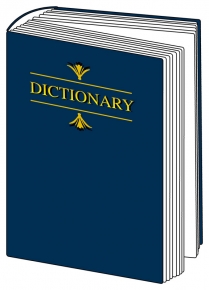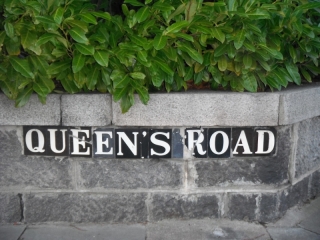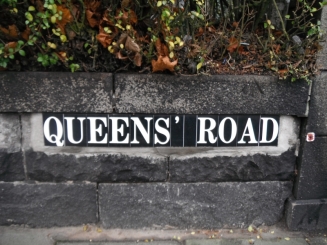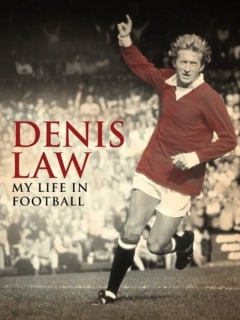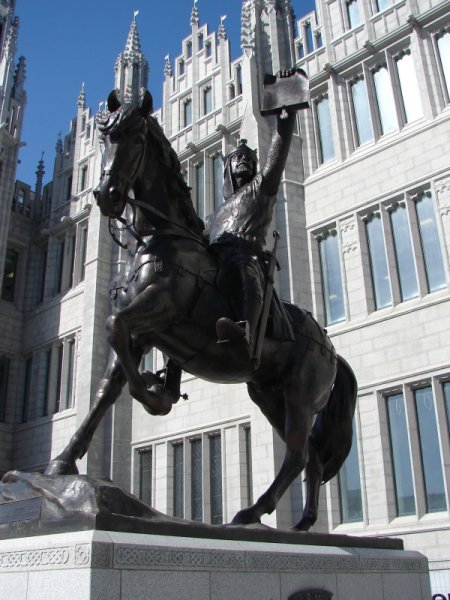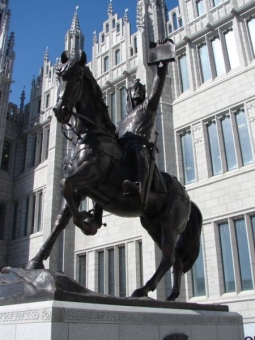Voice’s Old Susannah takes a look over the past week’s events in the ‘Deen and further beyond ( including the murky depths of ‘local’ cyberspace ). By Suzanne Kelly.
Across Aberdeen this past week most of us have enjoyed the last warm(ish) days of summer, and the sunny days and early evenings. Others have been glued to their computers waging a curious battle over a protest planned for tomorrow (Saturday 22nd September).
In the quest to win new friends and influence people, the ‘Protest Against Aberdeen City Council’ Facebook pages have entertained a wide variety of opinions, and a wide spectrum of humour (I am using the term ‘humour’ loosely).
Somewhere between 12 and 500 people will appear at 1pm tomorrow in front of the Marischal College building (which will be deserted, as it’s Saturday), to protest against Aberdeen City Council, Labour, and the death of the granite web.
An interesting report is to go before the Audit Committee soon; it is by an independent reporter who finds that both the councillors and the officers of Aberdeen City Council need to think about how they interact.
Anyone who read about this report in the Press & Journal would have been shedding tears, assuming this bullying was 100% by mean councillors against poor but honest officers. Indeed. More on that later.
But the real talk of the whole country is around the most fundamental question of all, which is dividing the Scottish nation, setting brother against brother, and causing an affa bother: is the deep-fried Mars bar a national treasure or not? Earlier on, the Mars company reportedly disowned the creation; other sources later claimed the Mars business had embraced the calorific snack.
This crucial question will no doubt be the subject of several independent consultations, a referendum, Holyrood debate, health & safety analysis, a PR campaign by the BiG partnership featuring Morris the Monkey, and more than a few bar room fights.
Some people claim that the original, unadorned Mars bar was good enough as it was, and should be retained. Others claimed it wasn’t 21st century enough unless it was covered with a web of deep fried flour and grease. Not since Culloden has such bickering been seen in this part of the world. Old Susannah hopes resolution is possible.
There have been a few amusing news stories across the UK as well.
Just tell that to your boss next time you need a few grand on your company’s credit card; I’m sure they won’t mind
Seems some of those nice people at Scottish Enterprise have been very enterprising indeed. Old Susannah never realised what a generous employer SE was, but it is kindly allowing staff to take SE credit cards and take out nice big, fat juicy cash advances (in a variety of currencies), and paying the amounts back as and when.
As a taxpayer, I’m so pleased we can help out the less fortunate SE employee with the odd £10K loan or two. It’s alright though, as the employees always intended to pay the money back. Just tell that to your boss next time you need a few grand on your company’s credit card; I’m sure they won’t mind.
It’s almost as if proper financial controls were not working 100% at SE – which is a bit unfortunate in such a tiny organisation; they still operate on a mere £750,000,000 or so per annum (much of which is salary – which Old Susannah finds difficult to reconcile with the cash advances the cash-strapped staff seem to need).
And in England, a woman has been sentenced for hijacking a ferry boat, telling her pursuers ‘I’m Jack Sparrow!’ and sailing away until finally caught.
Readers will find it hard to believe, but she was high on drink and belladonna (deadly nightshade to you and me, which is quite poisonous). I prefer the odd BrewDog and crisps, myself. After two days of drink and hallucinogens, she felt ill for some reason or other, and called the paramedics.
When they arrived she was, naturally enough, on a moored ferry boat, as you do. She ‘didn’t mean to untie the craft, but the ropes kept getting under her feet’. Fair enough – could have been any of us really. The ferry boat’s owner told the BBC this incident was a:-
“total one-off bizarre incident which we have never experienced before”.
Old Susannah should hope so, too.
I’m afraid the definitions this week do involve the web; don’t worry – this too shall pass.
Carrot or the Stick: (English saying) to offer an inducement – reward and/or sanction to gain support or agreement.
Any movement needs to recruit new members. Those nice Scientology people give out free books on Oxford Street, and tell you how clever you are. Next thing you know, you’re married to Tom Cruise and waiting for the mothership. The Moonies used to give out flowers; various missionaries would trade a square meal in exchange for preaching at you.
The Friends of Union Terrace Gardens and Common Good Aberdeen – two forces with the same ultimate goal of saving UTG from development have web presences, hold meetings, and hold the odd demo or two. New members and the curious are welcome.
Speaking of odd demos, there is a group called ‘Protest against Aberdeen City Council’ holding the demonstration I mentioned before, taking place tomorrow. They too have a web page and embrace open debate. And what a debate it has been.
The finest minds in all of Scotland’s past pale into insignificance against the rhetoric, logic, self-restraint and persuasive skills of a small number of the posters on this page. I’m surprised we’ve not all been convinced the web’s the way to go by this bunch.
The page’s administrator, who apparently lives in the United States, has allowed a wide raft of comments to go unmoderated, which I’m sure doesn’t mean they are encouraging trolls at all.
Usually when you want someone to come around to your way of thinking, you offer them some reason to do so – the proverbial carrot and the stick. The Big Partnership, recently rendered silent on the topic of the web, used both the carrot and the stick to get us to join the granite web fanclub.
There is an explanation of why the English Defence League has nothing to do with hate or violence
The carrots were ‘build the web and 6,500 new jobs appear’, ‘two hundred million pounds will magically flow into the city annually until the year 2023 (not 2022 or 2024 – 2023) AND the added incentive that Morris the Monkey and Jake the Ghost want the web convinced us in the thousands.
The sticks used to try and beat us into submission?
‘No one will come to Aberdeen’, ‘we’ll look silly if we don’t take Ian’s £50 million and do what he says with it’ and ‘people will think Aberdeen is ‘closed for business.’
I always liked this last ‘closed for business’ argument. It was supposed to make me think of a vibrant and dynamic shopping mall, doing lots of business. Instead, it made me think of an indiscriminate callgirl who would do anything with anyone if the price was right.
How are the ‘Protest against Aberdeen’s’ members and posters winning hearts and minds? Reasoned argument? Supplying facts and figures? Welcoming newcomers? Parrying dissent with rapier-like wit and friendly banter? Absolutely!
Please do go and visit this page yourself – it has all the relevant facts you need to know to make an informed decision to support the web. These include colourful postings such as the following:-
* There is an explanation of why the English Defence League has nothing to do with hate or violence;
* there is a woman being insulted because of her looks;
* there is a man who says he’s no longer onside with the protest because of the abusive comments made by protest supporters – so he’s attacked as being a ‘plant’;
* a man who was abused as a child is asked if he was ‘a little sh*t who deserved a clip ‘round the ears’;
* there is a woman who ‘has it on good authority’ that all the bills the taxpayer has already picked up for the web were really somehow not paid by the city council (who the invoices were made out to), but Sir Ian really picked them up; and
* a hilarious joke about building a mosque on UTG (alas; Old Susannah is unable to appreciate the witticism or the point being made)
People against the web have in several instances risen to the bait and argued back. But whatever side of this issue you are on, have a look at the comments made by people like Sandy M, George S and others. They’ll have won you over with their carrots and sticks before you know it.
Readers of a sensitive disposition may, however, wish to stay well clear. https://www.facebook.com/events/456202784419418/
Cautionary Tale: (compound noun; English) A story intended to impart advice by showing someone else’s error.
This new Information Commissioner is taking no prisoners – well, actually she might be, as the police have been called in to enforce the law.
This kind of development in Aberdeenshire is extremely worrying! The local authority seems to have accidentally denied it had information and accidentally deleted the information it denied having. It was almost as if there was something to hide, and as if the law came second to what the local government mandarins wanted.
This story, covered in this past week’s Press & Journal (really) implies that Freedom of Information requests have to be answered with the truth, the whole truth, and nothing but the truth. Old Susannah is reassured that there won’t be any such issues here in our city.
Even if the Information Commissioner’s office is reportedly auditing the work our FOI office does, it’s not as if information has ever been withheld from me, or anyone else, is it? (Unless of course you count requests about Mr S Milne, the deer cull, cost of Marischal college…)
Pre-emptive strike: (compound noun; English) a form of defence or deflecting attention by attacking one’s opponent first.
Well, a report going to the Audit Committee next week seems to imply that councillors had in the recent past not been treating officers courteously and had asked difficult questions. Naughty!
No real naming and shaming was done. I hope no councillors asked awkward questions of Pete Leonard for instance. Mean councillors in the past may have asked him why he kept representing that the deer-culling, tree-planting scheme was completely cost neutral, even though he knew for months that phase one failed, and ACC had to repay £43,800 for the dead trees.
He recently tried to deflect this irritating fact by reportedly saying £43,800 referred to something in the 1990s. Just because the money was paid in March 2011, when he was saying the great scheme was cost neutral to the Housing Committee, is no reason to think he wasn’t accurate or completely open, is it?
A cynic could think this report’s suggestions that councillors should show more deference to officers like Leonard is a pre-emptive strike. Did the report authors know about all the assorted little machinations of Leonard and his ilk? I’d love to know. At least one person must have come out of this untarnished: the softly-spoken, always calm and rational Gerry Brough, kindly volunteer to the City Gardens Project.
Now that this report has come out, I hope city councillors will be warned by this pre-emptive strike not to ask any tough questions! Hope that’s settled then.
And there we leave it for now.
Next week: I will attempt again to escape from the granite web – unless Zoe finally writes back about those CGP radio ads, promising us the web for free. Will keep you posted.
- Comments enabled – see comments box below. Note, all comments will be moderated.
